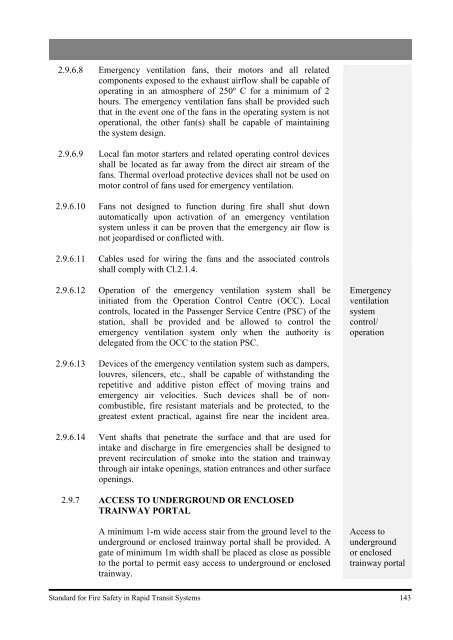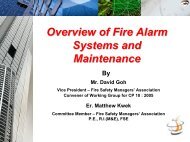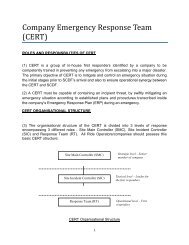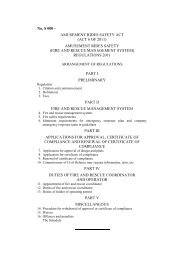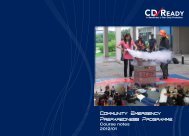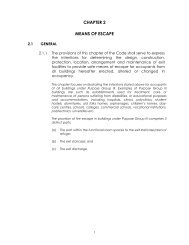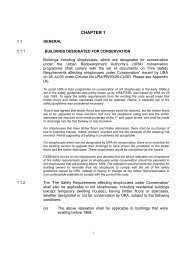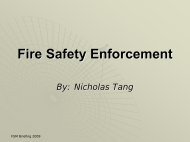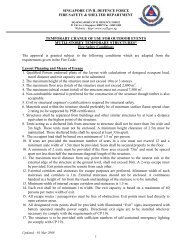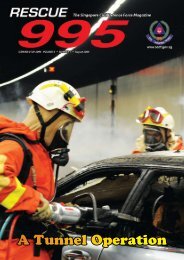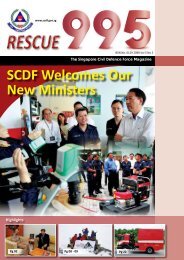Standard for Fire Safety in Rapid Transit Systems - Singapore Civil ...
Standard for Fire Safety in Rapid Transit Systems - Singapore Civil ...
Standard for Fire Safety in Rapid Transit Systems - Singapore Civil ...
You also want an ePaper? Increase the reach of your titles
YUMPU automatically turns print PDFs into web optimized ePapers that Google loves.
2.9.6.8 Emergency ventilation fans, their motors and all related<br />
components exposed to the exhaust airflow shall be capable of<br />
operat<strong>in</strong>g <strong>in</strong> an atmosphere of 250º C <strong>for</strong> a m<strong>in</strong>imum of 2<br />
hours. The emergency ventilation fans shall be provided such<br />
that <strong>in</strong> the event one of the fans <strong>in</strong> the operat<strong>in</strong>g system is not<br />
operational, the other fan(s) shall be capable of ma<strong>in</strong>ta<strong>in</strong><strong>in</strong>g<br />
the system design.<br />
2.9.6.9 Local fan motor starters and related operat<strong>in</strong>g control devices<br />
shall be located as far away from the direct air stream of the<br />
fans. Thermal overload protective devices shall not be used on<br />
motor control of fans used <strong>for</strong> emergency ventilation.<br />
2.9.6.10 Fans not designed to function dur<strong>in</strong>g fire shall shut down<br />
automatically upon activation of an emergency ventilation<br />
system unless it can be proven that the emergency air flow is<br />
not jeopardised or conflicted with.<br />
2.9.6.11 Cables used <strong>for</strong> wir<strong>in</strong>g the fans and the associated controls<br />
shall comply with Cl.2.1.4.<br />
2.9.6.12 Operation of the emergency ventilation system shall be<br />
<strong>in</strong>itiated from the Operation Control Centre (OCC). Local<br />
controls, located <strong>in</strong> the Passenger Service Centre (PSC) of the<br />
station, shall be provided and be allowed to control the<br />
emergency ventilation system only when the authority is<br />
delegated from the OCC to the station PSC.<br />
2.9.6.13 Devices of the emergency ventilation system such as dampers,<br />
louvres, silencers, etc., shall be capable of withstand<strong>in</strong>g the<br />
repetitive and additive piston effect of mov<strong>in</strong>g tra<strong>in</strong>s and<br />
emergency air velocities. Such devices shall be of noncombustible,<br />
fire resistant materials and be protected, to the<br />
greatest extent practical, aga<strong>in</strong>st fire near the <strong>in</strong>cident area.<br />
2.9.6.14 Vent shafts that penetrate the surface and that are used <strong>for</strong><br />
<strong>in</strong>take and discharge <strong>in</strong> fire emergencies shall be designed to<br />
prevent recirculation of smoke <strong>in</strong>to the station and tra<strong>in</strong>way<br />
through air <strong>in</strong>take open<strong>in</strong>gs, station entrances and other surface<br />
open<strong>in</strong>gs.<br />
2.9.7 ACCESS TO UNDERGROUND OR ENCLOSED<br />
TRAINWAY PORTAL<br />
A m<strong>in</strong>imum 1-m wide access stair from the ground level to the<br />
underground or enclosed tra<strong>in</strong>way portal shall be provided. A<br />
gate of m<strong>in</strong>imum 1m width shall be placed as close as possible<br />
to the portal to permit easy access to underground or enclosed<br />
tra<strong>in</strong>way.<br />
Emergency<br />
ventilation<br />
system<br />
control/<br />
operation<br />
Access to<br />
underground<br />
or enclosed<br />
tra<strong>in</strong>way portal<br />
<strong>Standard</strong> <strong>for</strong> <strong>Fire</strong> <strong>Safety</strong> <strong>in</strong> <strong>Rapid</strong> <strong>Transit</strong> <strong>Systems</strong> 143


